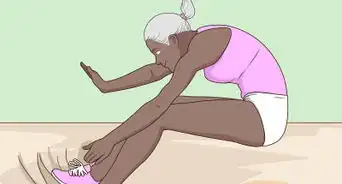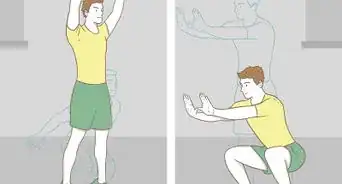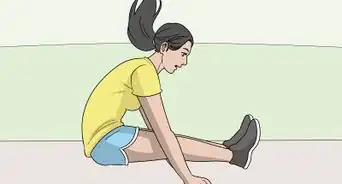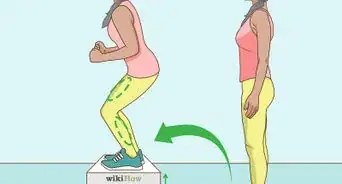This article was co-authored by wikiHow Staff. Our trained team of editors and researchers validate articles for accuracy and comprehensiveness. wikiHow's Content Management Team carefully monitors the work from our editorial staff to ensure that each article is backed by trusted research and meets our high quality standards.
wikiHow marks an article as reader-approved once it receives enough positive feedback. This article received 23 testimonials and 80% of readers who voted found it helpful, earning it our reader-approved status.
This article has been viewed 535,976 times.
Learn more...
The high jump track and field event requires skill, agility and speed. After sprinting to gain momentum, jumpers launch over a high bar and land on a crash mat on the other side. For your own safety, it’s important to practice good form when running towards the bar, jumping over it, and even landing. If you practice often and safely you can learn how to do a high jump!
Steps
Perfecting the Run
-
1Practice your running technique. When a jumping man runs towards the bar they are building the momentum necessary to jump over the bar.[1] Therefore, you need to perfect the running technique before you attempt to jump over anything. Practice by running towards a gymnastics mat and behaving as if there was a bar in front of it. This is the same kind of mat that will be behind the bar when you’re ready jump over it.
-
2Prepare to run towards the mat. Most jumpers only take about 10 strides before they jump over the bar, so make sure you’re at least ten paces away from the mat to simulate this.[2] If you’re a beginner step even further back about 5 to 6 strides to give yourself plenty of room to gain momentum.
- Don’t stand directly in front of the mat. You will be running in a “J” shape by turning towards the bar about ten strides into your run. Therefore, you need to be at least nine feet to the left or the right of the mat before you start running. If your right leg is dominant you should be to the right of the mat. If your left leg is dominant, go to the left of the mat.
- Women typically step 9 to 13 feet (2.7 to 4.0 m) to the left or right of the mat and begin their run 35 to 55 feet (10.7 to 16.8 m) back,[3] while men typically step 12 to 16 feet (3.7 to 4.9 m) to the left or right of the mat and begin 50 to 70 feet (15.2 to 21.3 m) back.[4]
Advertisement -
3Begin running. Use your non-dominant foot to push off. Some athletes start low to the ground and will be in an upright position by stride three. Do what is most comfortable for you, but while practicing it may be easier to start standing up.
- Be sure to run in a “J” shape. The path you create with your run will look like a "J" because you run straight and then curve toward the bar at the end. Run straight toward the corner of the mat for about 5 strides to gain momentum. Begin to curve so you will eventually be parallel with the bar after about 3 strides.
- Do not accelerate or decelerate. Maintain a consistent speed so your momentum is not lost.[5]
-
4Jump towards the mat. This can also be called a “push off.” Push off into the air with your non-dominant foot. The non-dominant leg will automatically be extended as you jump and you'll drive up your opposite knee.
- Don’t land on the mat. Instead, land on your feet. At this point you are just practicing the running form. However, the mat will help to catch you if you accidentally fall.
Clearing the Bar using the Fosbury Flop
-
1Practice the Fosbury Flop. This form was first used at the Olympics in Mexico City in 1968 by Dick Fosbury to win a gold medal.[6] His technique, affectionately called the Fosbury Flop, requires leaping head first with your back to the bar. It is now the most common technique among professional jumpers.
-
2Prepare to launch yourself over the bar. When you’ve finished the “J” run and are next to the mat, rotate your back to the bar for the Fosbury Flop. As you drive your knee up and push off from your non-dominant leg, pivot your body to face the sky. This may feel unnatural the first few jumps, but keep practicing until it becomes second nature.
-
3Clear the bar. Tilt your head and upper back toward the mat. Angle your head back and keep your chin un-tucked as you clear the bar to avoid injury. Arch your back up. As you arch and lift your hips over the bar, your head will fall back.[7] After your hips have cleared the bar you will naturally tuck your head to your chest to help lift your feet over.
- Lift your feet up and over. Timing is critical here as there may only be a small amount of clearance for getting your legs over the bar. As your hips cross the bar and come down, give your legs a quick kick up and over to clear the bar.[8]
- Try to keep your arms close to your body for a more solid center of gravity.
-
4Land on the mat properly. Touch the mat with your upper back first. After clearing the bar you'll want to land on your upper back and shoulders to avoid injury. The rest of your body will follow and it may feel right to let the movement turn into a backward tumble. If so, relax and try to roll into the tumble.
- If you tumble, push the roll to either the left or right side of your upper back and put your body's weight over the respective shoulder (rather than directly over the head) so the pressure is distributed away from the neck.[9]
- Keep your mouth closed. If you hold it open, you may bite your tongue.
-
5Resist the reflex to curl up. Keep your body open so that you don’t smash your knees against your face. Don't relax once your back touches the mat, and keep your legs a comfortable distance apart from each other as your knees will likely bend and come forward, even if you aren't rolling backward.[10]
- If you hit the bar while jumping, it may be knocked off of its perch and into the air. If so, it may fall on you, on the mat, or be on an angle that could harm you if you land on it. If you hit the bar, cover your face with your arms while landing to prevent being injured by the bar.
-
6Improve your jump height and form. Practice jumping and landing until you’re completely comfortable with it. Nobody learns to high jump overnight, so don't get down on yourself if you find it challenging at first. Practice as much as you can and talk with other high jumpers or coaches to get tips. If a friend is watching they can give you pointers on how your form looks and help you perfect the landing on the mat.
- To push yourself, raise the bar in increments of 3 centimeters (1.2 in). Three centimeters may seem small, but you'll feel the difference the next time you try it.
- Some people find it helpful to record their progress in a journal. To do so, write down the height of the bar you’re jumping over as you practice. If you continue to raise the bar each week and record your highest jumps, you can track your improvement.
Clearing the Bar using Scissor Jumps
-
1Clear the bar using scissor jumps. If the head-first flop looks too daring at this stage, you may choose to jump the bar a different way. A simple, less complicated jump called a “scissor jump” is done by following the same run path. Instead of flinging yourself backwards over the bar, you cross over the bar in a sitting position with your back straight and your legs extended in front of you.[11]
- Make sure the bar is relatively close to the mat, especially if you’re a beginner. It’s important to master the technique before you attempt to jump over a high bar.
-
2Run towards the bar at a steady speed to gain momentum. If you’ve practiced the “J” run enough, you should be able to confidently run towards the bar with the correct form. Don't cut corners during the "J" run to save time; it's important to run the full path to give yourself more momentum to jump.
-
3Push off from the ground. When you practiced running, you jumped by pushing off with your non-dominant leg and thrusting your dominant knee into the air. This time, push off with your non-dominant leg but swing your dominant foot into the air, keeping your leg straight. You should be bent at the waist as if you’re sitting on the floor, and your foot should never be higher than your hips.
- When you jump your body should be parallel to the bar. You will be jumping in a “sideways” motion that will carry you over the bar.
-
4Complete the jump. Swing your non-dominant leg up towards your extended leg, keeping both legs straight. This will create a motion similar to scissors closing; thus, the name “Scissor Jump.” Keep your back straight and your legs extended in front of you. Your momentum will carry you over the bar and onto the mat.
-
5Improve your technique. Practice scissor jumping until you’re comfortable doing it. As you get better, increase the height of the bar slowly. Once you’ve reached your maximum height, it’s time to move on to a more advanced jumping form.
Community Q&A
-
QuestionCan I do the scissors instead of a flop because I don't do that technique?
 Community AnswerScissor-kicking is an acceptable technique. However, it is normally used for lower heights. So, it's okay if you don't do it now, but to be better, it's recommend that you start learning this method.
Community AnswerScissor-kicking is an acceptable technique. However, it is normally used for lower heights. So, it's okay if you don't do it now, but to be better, it's recommend that you start learning this method. -
QuestionWhat exercises should I do to get better at high jump?
 Community AnswerI would focus on things like lunges and calf stretches since you'll use those muscles a lot when high jumping.
Community AnswerI would focus on things like lunges and calf stretches since you'll use those muscles a lot when high jumping. -
QuestionHow do I jump higher?
 Community AnswerSwing your arms upwards during your lift, this will add momentum. Crouch on your jumping leg slightly, and try boosting upwards. To twist and arc, start the twist immediately, and save the bend for when you think (or know) the bar has reached below your shoulder.
Community AnswerSwing your arms upwards during your lift, this will add momentum. Crouch on your jumping leg slightly, and try boosting upwards. To twist and arc, start the twist immediately, and save the bend for when you think (or know) the bar has reached below your shoulder.
Warnings
- Never high jump without a safety mat as you can cause serious harm to your body.⧼thumbs_response⧽
- Avoid practicing alone. If you get injured, no one will be around to help you!⧼thumbs_response⧽
- This article is meant to inform a beginner. For more serious inquires you may want to go to a high jump coach who can figure out your needs in order to perform better.⧼thumbs_response⧽
- Place small mats around the large high jump mat if you think you'll need additional protection.⧼thumbs_response⧽
- Never attempt the high jump using a mattress as the mat. It might sound like a good idea but if you land hard you could fly off and land on the ground.⧼thumbs_response⧽
Things You'll Need
- Tape measure (to measure height when you raise the bar)
- Full high jump pit set (mat/landing pit, standard cross bar support, and elastic bar)
- Track area
- Friend or coach
- Water and maybe a snack (depends on how long your going to be there)
References
- ↑ http://www.coachr.org/hj.htm
- ↑ http://www.coachr.org/hj.htm
- ↑ http://assets.ngin.com/attachments/document/0035/6344/hj_coaches_clinic_supporting_doc_20130201.pdf
- ↑ http://assets.ngin.com/attachments/document/0035/6344/hj_coaches_clinic_supporting_doc_20130201.pdf
- ↑ http://assets.ngin.com/attachments/document/0035/6344/hj_coaches_clinic_supporting_doc_20130201.pdf
- ↑ https://www.youtube.com/watch?v=XBtBdNHBNSI
- ↑ http://assets.ngin.com/attachments/document/0035/6344/hj_coaches_clinic_supporting_doc_20130201.pdf
- ↑ http://assets.ngin.com/attachments/document/0035/6344/hj_coaches_clinic_supporting_doc_20130201.pdf
- ↑ https://www.youtube.com/watch?v=XBtBdNHBNSI
About This Article
To do the high jump, start by standing 9 to 12 feet from the mat and to the right of it if your right leg is dominant, or to the left if your left leg is dominant. Next, push off with your non-dominant foot and run straight, for about 5 strides before running towards the corner of the mat. As you approach the mat, rotate your back toward the bar, push off with your non-dominant foot, and drive your knee into the air. Then, pivot your body to face the sky, angle your head back, and arch your back and hips over the bar. Finally, give your legs a kick to lift them up and over the bar. To learn how to use scissor jumps to do the high jump, scroll down!
-Step-1-Version-4.webp)
-Step-2-Version-4.webp)
-Step-3-Version-4.webp)
-Step-4-Version-4.webp)
-Step-5-Version-4.webp)
-Step-6-Version-4.webp)
-Step-7-Version-4.webp)
-Step-8-Version-4.webp)
-Step-9-Version-3.webp)
-Step-10-Version-2.webp)
-Step-11-Version-2.webp)
-Step-12-Version-2.webp)
-Step-13-Version-2.webp)
-Step-14-Version-2.webp)
-Step-15-Version-2.webp)


























































